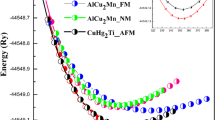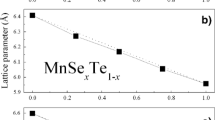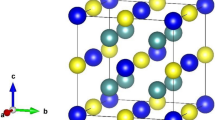Abstract
Magnetic functional materials remain an area of research interest for applications in electronic devices. Among these materials, Mn50Pt50 alloy has received a great deal of attention in practical potential applications such as spintronics due to its high-thermal and magnetic stability. It was reported previously that L10 Mn50Pt50 alloy shows ferromagnetic ordering at room temperature. In this study, the effect of the partial substitution of Pt with Co was investigated using density functional theory (DFT) approach. The thermodynamic, magnetic and mechanical properties were determined to check the stability of Mn50Pt50-xCox alloys. The results showed that the L10 phase has the lowest heat of formation when the c/a ratio is 1.10 for 6.25 at.% Co. Overall magnetic moments improve with an increase in Co compositions when the c/a ratio is 1.10. The obtained results reveal that Mn50Pt50-xCox alloys exhibit attractive magnetic and mechanical properties for future magnets in spintronics applications.
Graphical Abstract

Similar content being viewed by others
Avoid common mistakes on your manuscript.
Introduction
There is a great deal of technological importance in Mn-based alloys, especially in the information technology industry. These alloys are used in magnetic and magnetoelastic sensors, hard drive components, spintronics, and other biomedical devices. This is due to their interesting hard magnetic properties and low cost [1]. Recently, several Mn-based alloys, including Mn-Pt, were discovered to exhibit ferromagnetism. At low temperatures, this alloy transforms from a cubic phase of B2 (CsCl) to a tetragonal phase of L10 (CuAu-I) through a diffusionless martensitic process [1]. Particularly, L10 Mn50Pt50 has potential due to its large magnetic crystalline anisotropy. The L10-type phase of Mn50Pt50 is reported to have a very high Ne ́el temperature (TN) of 970 K [2]. This high Ne ́el temperature of the Mn50Pt50 alloy make it suitable candidates for on-chip applications [3].
Considering its high stability, Mn50Pt50 alloy has been intensively studied from the viewpoint of applications in giant magnetoresistance (GMR) and tunnel magnetoresistance (TMR) devices [4, 5]. It is vital that investigations on fundamental magnetic properties of these practical ferromagnets be conducted in order to tailor excellent properties required in GMR and TMR devices since exchange biasing characteristics are closely related to the spin structures, magnetocrystalline anisotropy energy (MAE), as well as the magnitude of TN. Consequently, there is a need to search for optimal property combination through alloying in attempt to expand the application of the Mn50Pt50 alloy. In this study, the 3d element cobalt (Co), which is ferromagnetically ordered above room temperature, is introduced on Pt-sub-lattice site. The effect of ferromagnetic element (Co) on the magnetic properties of Mn50Pt50 alloy was investigated using the first-principles calculations based on density functional theory (DFT). It was found that the addition of Co on both B2 and L10 Mn50Pt50 results in improved magnetic strength and mechanical stability.
Methodology
The first-principle calculations were performed using the plane-wave basis approach based on DFT, as implemented in the VASP code [6, 7]. An electron and core interaction were included by using the frozen-core all-electron projector augmented wave (PAW) method [8]. The exchange–correlation function was treated by the generalized gradient approximation (GGA) [9]. proposed by Perdew, Burke and Ernzerhof (PBE) [10]. A spin polarization was included in the calculations. A plane-wave energy cutoff of 500 eV was used for all cases to ensure a high degree of accuracy of about 1 meV per atom. The special points sampling integration over the Brillouin zone was employed by using the Monkhorst–Pack scheme [11] with a mesh grid of 14 × 14 × 14 for B2 and 15 × 15 × 12 for L10. Calculations were performed on a 2 × 2 × 2 supercell with 16 atoms for cubic and 32 atoms for tetragonal crystals. The ternary Mn50Pt50-xCox alloys were constructed using a substitutional search tool within the Medea software and Pt was substituted with Co. The search tool provided the most stable compositions such as 6.25, 12.50, 18.75 and 25 at.% with desired symmetry. When calculating elastic properties such as elastic constants, a maximum strain value was 0.005%.
Results and discussion
Thermodynamic and magnetic properties
The calculated heats of formation and magnetic moments of the B2 and L10 Mn50Pt50-xCox compounds are given in Fig. 1a and b, respectively. The relative thermodynamic stabilities of compounds are closely related to their heats of formation. Generally, the more negative heats of formation (∆Hf < 0) suggest higher thermodynamic stability.
The heats of formation of Mn50Pt50-xCox were obtained using the following formula:
where Ec is the calculated total energy of the compound and Ei is the calculated total energy of the pure metal in their ground-state. The calculated heats of the formation of the considered alloy compositions are presented in Fig. 1a. The calculated heats of formation for B2 Mn50Pt50-xCox alloys are negative (except for B2 Mn50Pt31.25Co18.75) indicating that they are thermodynamically stable structures. At 6.25 at.% Co, it is noted that the thermodynamic stability is favoured for the L10 phase for various c/a ratios. In the case of 12.5 and 18.75 at.% Co, L10 is thermodynamically stable except when the c/a ratio is 1.30 (12.5 at.% Co) and 1.20 ratio (18.75 at.% Co). Unfortunately, at 25 at.% Co, the alloy does not form as indicated by positive heats of formation when c/a is 1.20 and 1.30, which suggests thermodynamic instability.
Figure 1b shows the magnetic moments of the B2 and L10 Mn50Pt50-xCox alloys. The magnetic moments were determined to investigate the magnetic strength of the structures. It is noted that the B2 Mn50Pt50-xCox structures shows higher magnetic moments as compared to Mn50Pt50, except for Mn50Pt25Co25. This behaviour suggests that Co can be used to improve the magnetic strength of the B2 phase below 25 at.% Co. Similar behaviour was observed for the L10 phase when c/a is 1.10 as the values of magnetic moments increase with an increase in Co content for the entire considered composition range (0 ≤ x ≤ 25) (see Fig. 1b). Furthermore, the ferromagnetism is maintained for 6.25 at.% and drops above 6.25 at.% Co when c/a = 1.20 and 1.30. At 25 at.% Co (c/a = 1.10), L10 phase has slightly higher magnetic moments compared to B2.
Structural properties
A full geometry optimization was conducted on the structures that could be formed with Co addition as discussed above. In the full optimization process, both lattice geometry and ionic positions were optimized until the Hellman–Feynman forces were less than 0.01 eV/Å. Figure 2a–d shows the calculated equilibrium lattice parameters for Mn50Pt50-xCox alloys (0 ≤ x ≤ 25). A binary model (Mn50Pt50) was validated by comparing the calculated lattice parameters with the theoretical values. The equilibrium lattice parameter of binary B2-paramagnetic (PM) Mn50Pt50 is predicted to be 3.00 Å (3.01 Å) [12] which agrees well with theoretical data (in parenthesis) to within 2%. Currently, there is no theoretical or experimental value available for the lattice parameters (3.12 Å) of the Ferromagnetic (FM)-B2. L10 phase alloys have a c/a ratio of 1.10–1.30, but little research has been conducted on the impact of alloying on the lattice parameters. It is noted that the equilibrium lattice parameters of the B2 Mn50Pt50-xCox decrease as Co content is increased (see Fig. 2a). This is expected since the atomic radius of Pt (1.83 Å) is larger than Co (1.52 Å). When c/a is 1.10, the lattice parameter a increases with Co addition, while the lattice parameter c decreases for the L10 phases, except for 18.75 at.% Co where the opposite trend is observed. As a result, the introduction of Co leads to lattice contraction along the c direction and expansion along the a direction, yielding to overall reduced c/a ratio within the Bain transformation path [13]. A similar trend is noticed when c/a is 1.20 and 1.30 as shown in Fig. 2c and d. In addition, it is noted that the a and c lattice parameters showed almost similar values when c/a is 1.20 and 1.30 for 12.5 and 18.75 at.% Co, respectively, signalling tetragonal to cubic transformation tendency when a = c.
Elastic properties
It is important to analyse the elastic properties of materials because they determine mechanical stability based on elastic constants (Cij). Elastic constants describe how crystals react to macroscopic stresses and are important to material strength. The cubic system has three different elastic constants, c11, c12 and c44. The mechanical stability criteria are given by [14]:
where the shear modulus (C′) can be calculated as:
For a tetragonal system, there are six independent elastic constants: c11, c12, c13, c33, c44 and c66. The required mechanical stability in a tetragonal system leads to the following equation:
The stability criterion for the elastic constants must be satisfied for the structure to be stable. In this paper, the calculated single-crystal elastic constants of these compounds are listed in the Table and Figures below. Table 1 lists the elastic constants of Mn50Pt50 structures together with available theoretical data. To the authors knowledge, the elastic constants for FM-B2 Mn50Pt50 have not been experimentally measured for comparison nor have they been calculated by ab initio calculations. It is noted that c11 < c12 which indicates instability of the PM-B2 Mn50Pt50 according to Eq. 2. More importantly, the obtained elastic constants for PM-B2 Mn50Pt50 agree well with the theoretical value [12] to within 2%. The FM-B2 Mn50Pt50 is found to be mechanically stable as the elastic constants satisfy the stability criteria.
Figure 3a–d shows the elastic constants of the structures which can form with the addition of Co for both B2 and L10 Mn50Pt50-xCox (0 ≤ x ≤ 25) compositions. The elastic constants c11, c12 and c44 are positive for the B2 Mn50Pt50-xCox as shown in Fig. 3a. The c11 increases above 6.25 at.% Co while c12 decreases suggesting that the structure is becoming mechanically stable (satisfying the stability condition, c11 > c12), which only occurs as from 12.5 at.% Co. However, it is noted that below 6.25 at.% Co, the C′ is negative, which renders the structures mechanically unstable at these compositions. The results suggest a strong martensitic transformation tendency at 6.25 at.% Co due to the most negative C′. In the case of L10 Mn50Pt50-xCox (c/a = 1.10), the elastic constants c11, c12 and c44 are positive for 6.25, 12.50 and 25 at.% Co (see Fig. 3b). The elastic constants decrease with the addition of Co content below 12.5 and increase above this composition, suggesting that the structure is becoming mechanically stable (satisfying stability condition). Clearly, it is noted that the Cij for ternary alloy compositions are less than those for the binary L10 Mn50Pt50 structure, which indicates that the alloying element (Co) has no potential to improve the Cij of pure structure. Furthermore, the elastic constants of L10 Mn50Pt50-xCox, when the c/a = 1.20 and 1.30, are shown in Fig. 3c and d, respectively. As the composition of Co is increased, the elastic constants (c11, c12, c13, c33, c44, c66) decrease and reach an equal value at 12.5 at.% Co. This suggests that the structure may transform to a B2 phase above this composition (> 12.5 at.% Co). Surprisingly for c/a = 1.30, it is noted that values of elastic constants increase until 18.75 at.% Co. The results suggest that at this Co composition the L10 phase is the most mechanically stable.
Conclusion
An Ab initio DFT approach was used to study thermodynamic, magnetic and elastic properties of Mn50Pt50-xCox (0 ≤ x ≤ 25) compositions for potential spintronic applications. The results for PM B2 Mn50Pt50 were found to be in good agreement with available experimental and theoretical data to within 2%. The results suggested that the addition of Co favours L10 compared to B2 phase due to negative heats of formation (∆Hf < 0). Furthermore, it was found that the magnetism is improved for B2 Mn50Pt50-xCox (x = 6.25, 12.50, 18.75) except for x = 25. In addition, B2 Mn50Pt50-xCox above 12.5 at.% Co does not satisfy stability criteria for cubic crystals. From thermodynamic phase stability and magnetic strength point of view, the addition of Co on Pt-site favours L10 phase compared to B2 phase.
Data availability
Data reported in this paper is available upon request to the corresponding author.
References
J. Yang, W. Yang, Z. Shao, D. Liang, Chin. Phys. B 27, 117503 (2018)
R.Y. Umetsu, K. Fukamichi, A. Sakuma, Mater. Trans. 47, 2–10 (2006)
V. Baltz, A. Manchon, M. Tsoi, T. Moriyama, T. Ono, Y. Tserkovnyak, Rev. Mod. Phys. 90, 0150 (2018)
R.F.C. Farrow, R.F. Marks, S. Gider, A.C. Marley, S.S.P. Parkin, D. Mauri, J. Appl. Phys. 81, 4986 (1997)
Z. Lu, R.V. Chepulskii, W.H. Butler, Phys. Rev. B 81, 094437 (2010)
G. Kresse, J. Hafner, Phys. Rev. B 47, 558–561 (1993)
G. Kresse, J. Furthmüller, Phys. Rev. B 54, 11169–11186 (1996)
P.E. Blöchl, Phys. Rev. B 50, 17953–17979 (1994)
W. Kohn, L.J. Sham, Phys. Rev. 140, 1133–1138 (1965)
J.P. Perdew, K. Burke, M. Ernzerhof, Phys. Rev. Lett. 77, 3865 (1996)
H.J. Monkhorst, J.D. Pack, Phys. Rev. B 13, 5188–1592 (1996)
J. Wang, A. Gao, W. Chen, X.D. Zhang, B. Zhou, Z. Jiang, J. Magn. Magn. Mater. 333, 93–99 (2013)
E.C. Bain, Trans. Am. Inst. Min. Metall. Engrs. 70, 25 (1924)
M.J. Mehl, B.M. Klein, Intermetallic Compd. 1, 1–26 (1994)
Acknowledgments
The work was carried out using computational resources at Materials Modelling Centre, University of Limpopo. The authors acknowledge the Advanced Materials Initiative (AMI) of the Department of Science and Innovation (DSI) through Mintek for their financial support. The support of the South African Research Chair Initiative of the DSI is highly appreciated.
Funding
Open access funding provided by Mintek.
Author information
Authors and Affiliations
Corresponding author
Ethics declarations
Conflict of interest
The authors declare that there is no conflict of interest.
Additional information
Publisher's Note
Springer Nature remains neutral with regard to jurisdictional claims in published maps and institutional affiliations.
Rights and permissions
Open Access This article is licensed under a Creative Commons Attribution 4.0 International License, which permits use, sharing, adaptation, distribution and reproduction in any medium or format, as long as you give appropriate credit to the original author(s) and the source, provide a link to the Creative Commons licence, and indicate if changes were made. The images or other third party material in this article are included in the article's Creative Commons licence, unless indicated otherwise in a credit line to the material. If material is not included in the article's Creative Commons licence and your intended use is not permitted by statutory regulation or exceeds the permitted use, you will need to obtain permission directly from the copyright holder. To view a copy of this licence, visit http://creativecommons.org/licenses/by/4.0/.
About this article
Cite this article
Diale, R.G., Ngoepe, P.E., Moema, J.S. et al. A computational study of the thermodynamic and magnetic properties of Co-alloyed MnPt. MRS Advances 8, 651–655 (2023). https://doi.org/10.1557/s43580-023-00568-4
Received:
Accepted:
Published:
Issue Date:
DOI: https://doi.org/10.1557/s43580-023-00568-4







